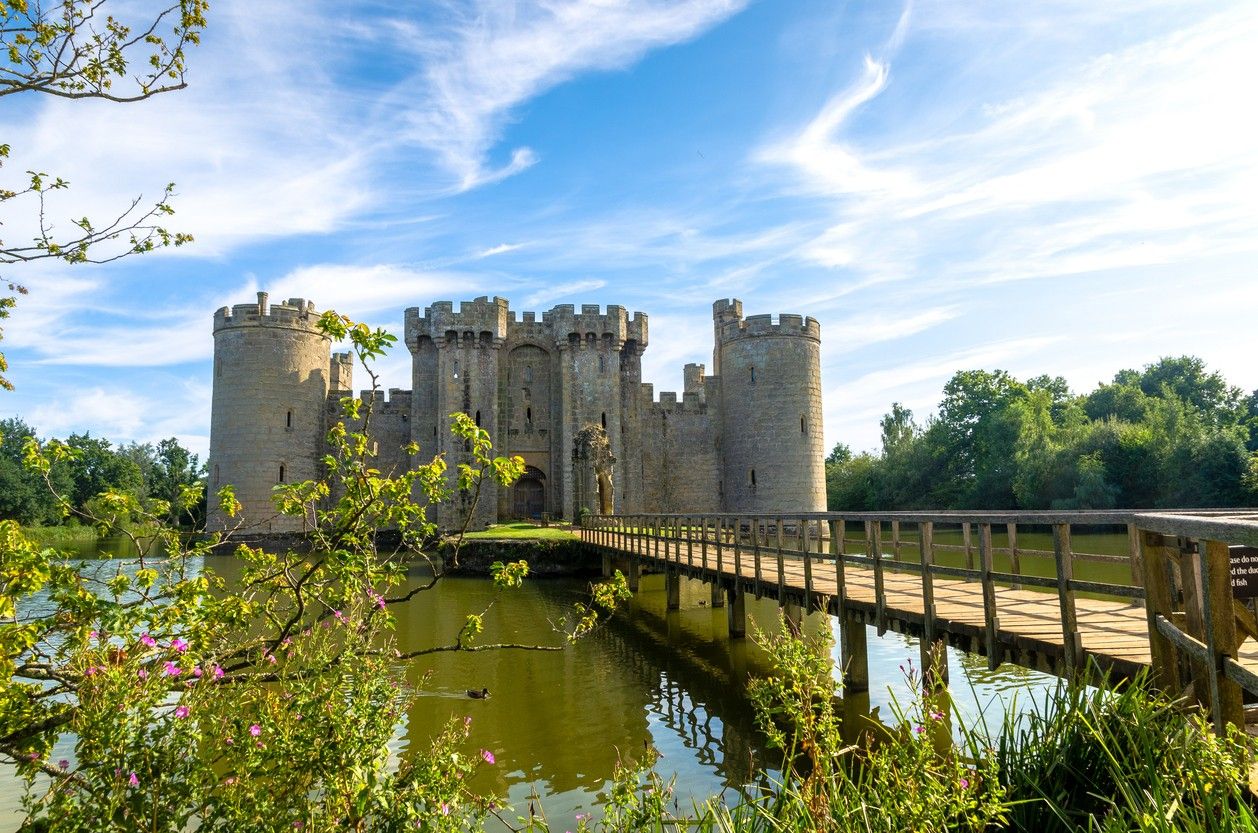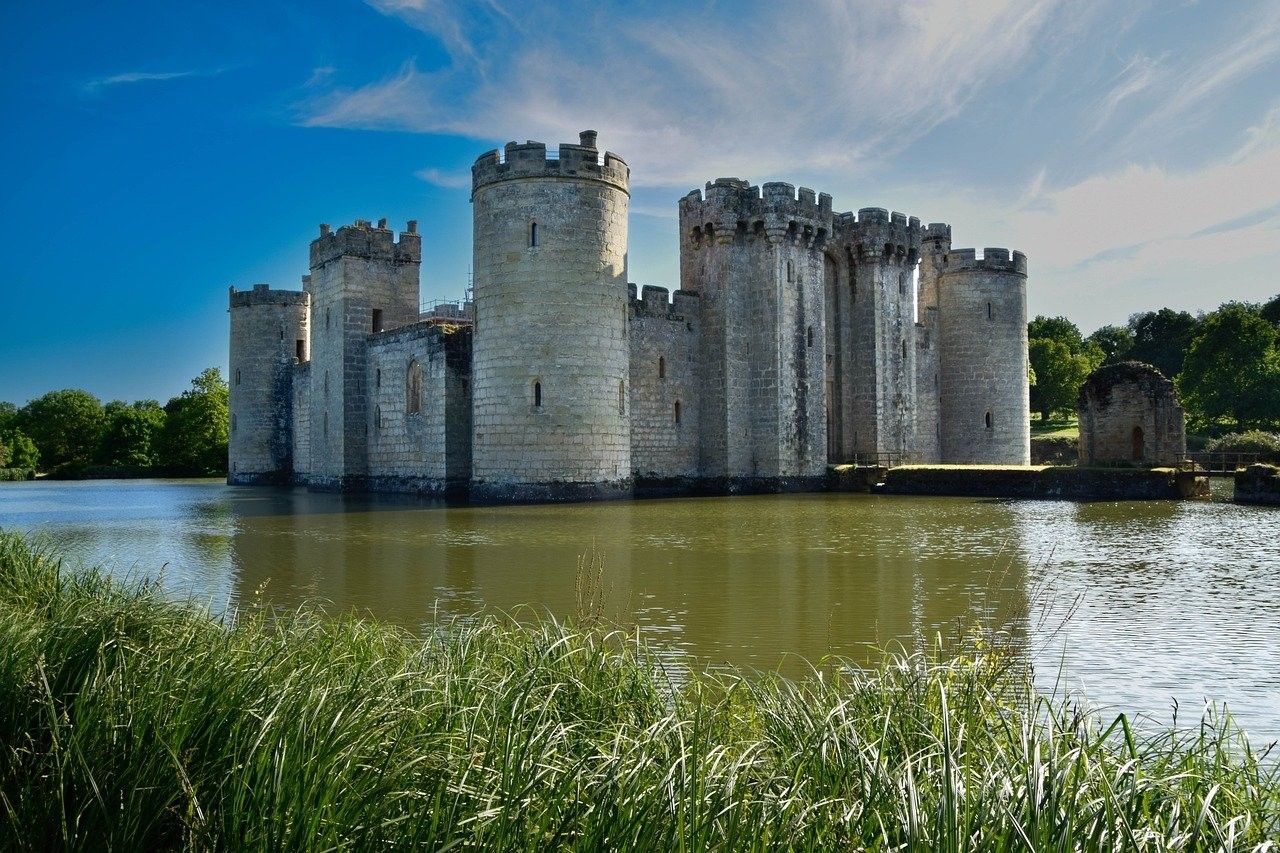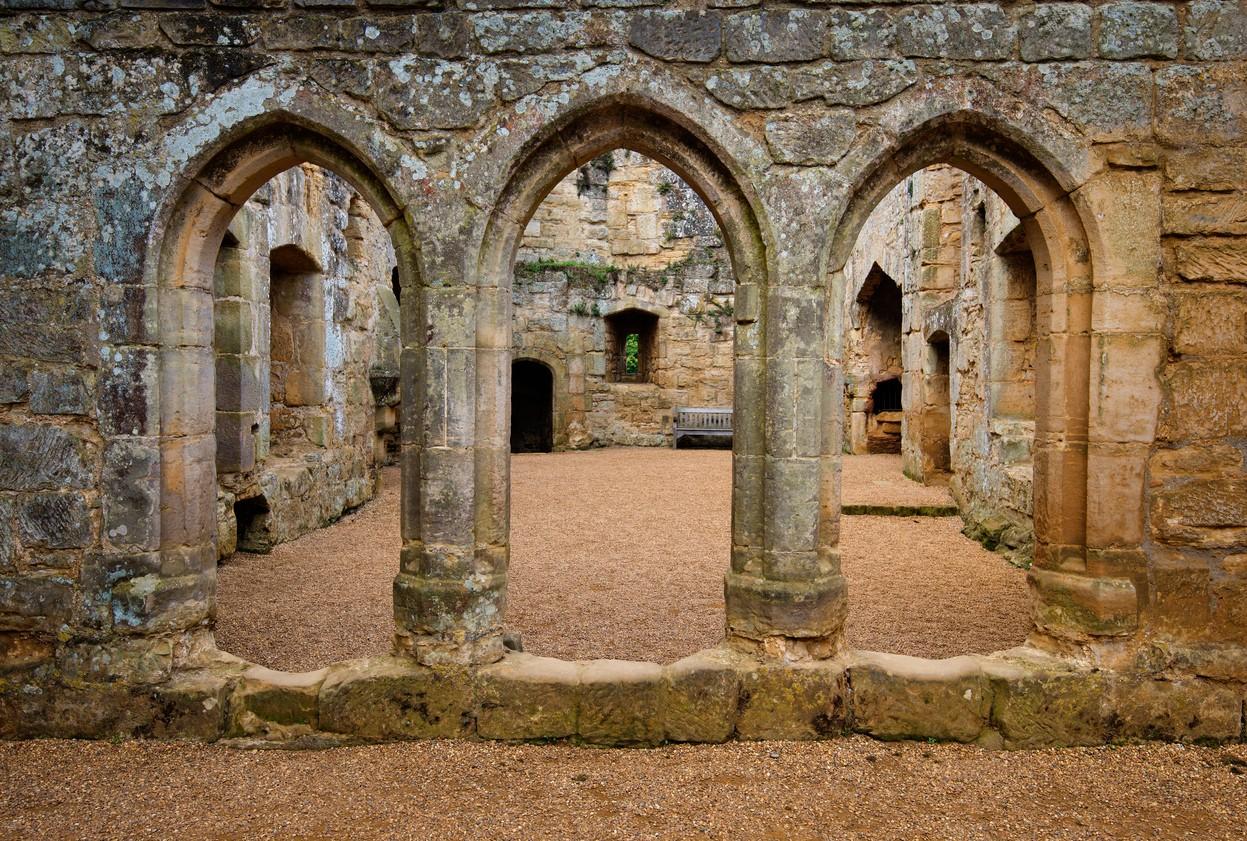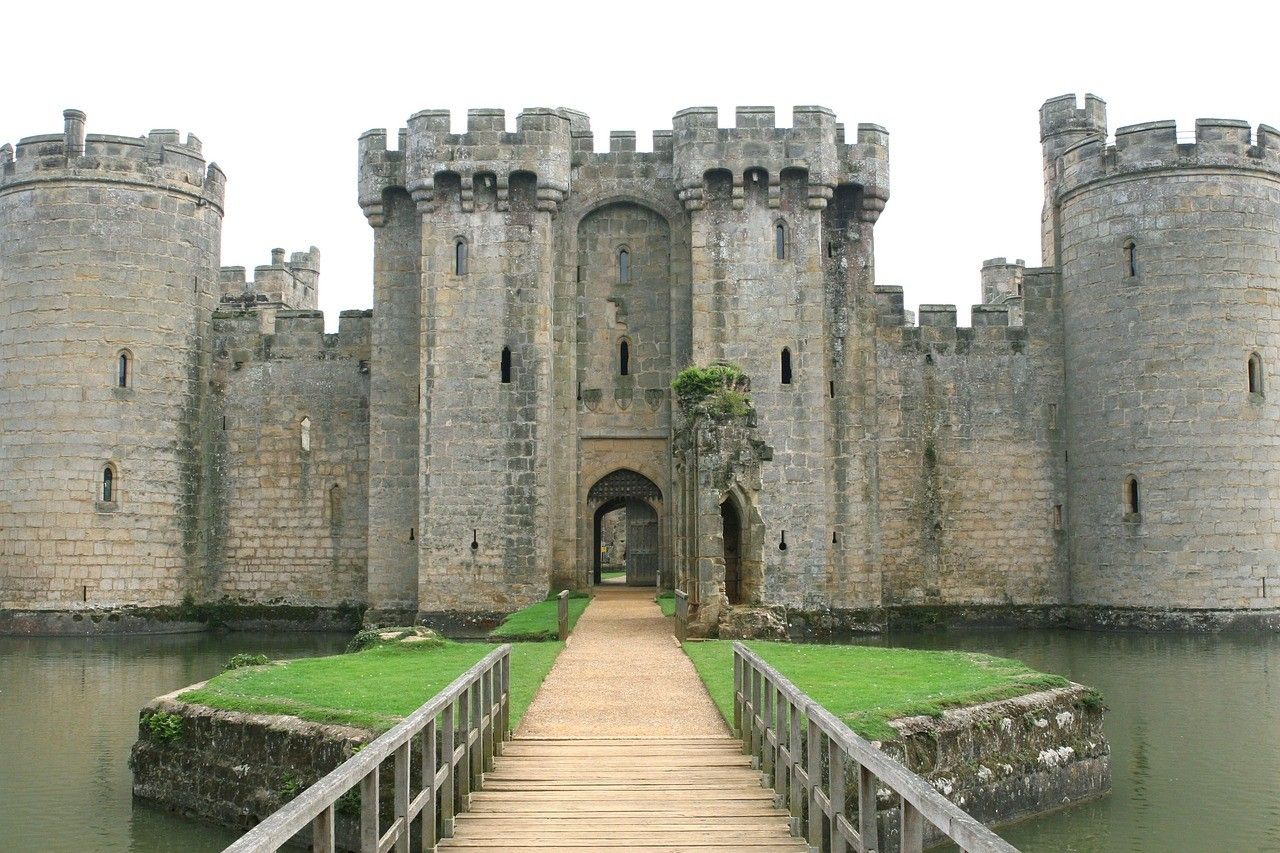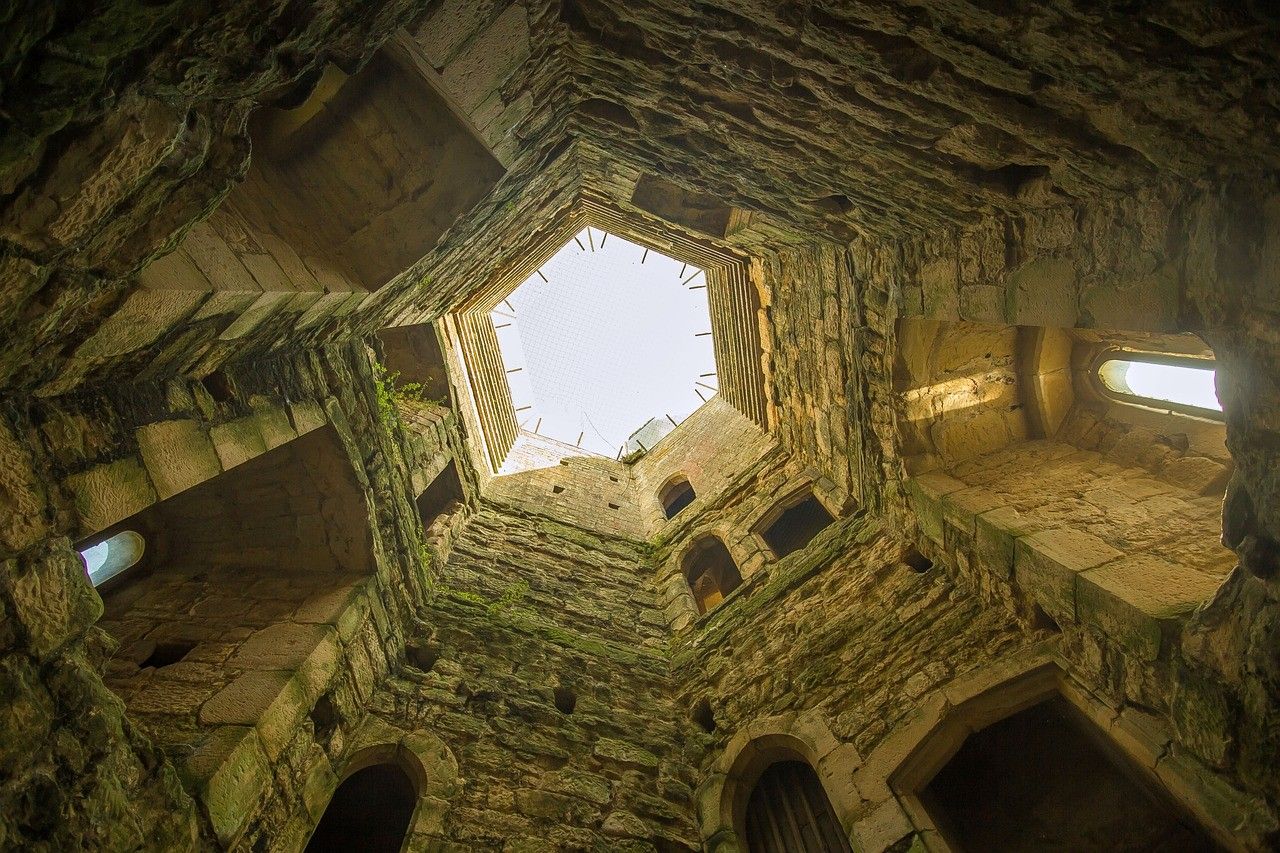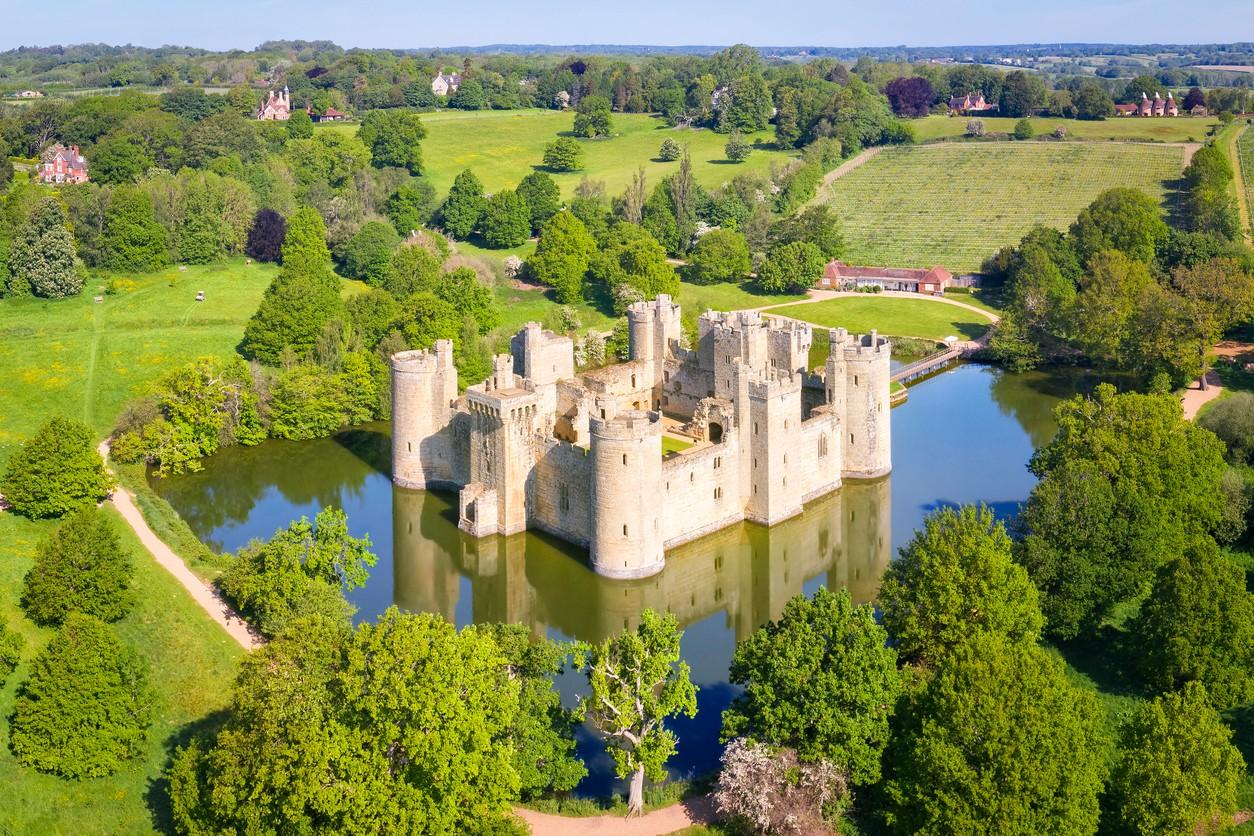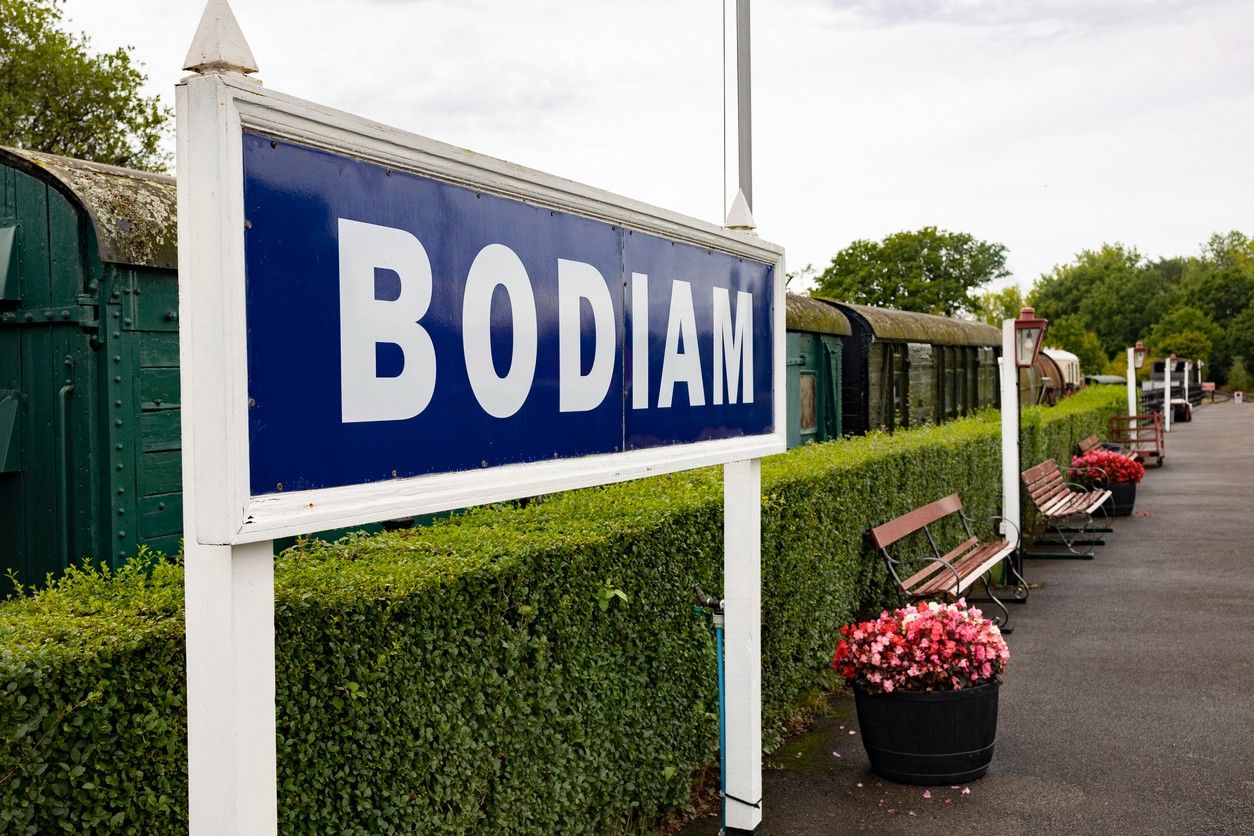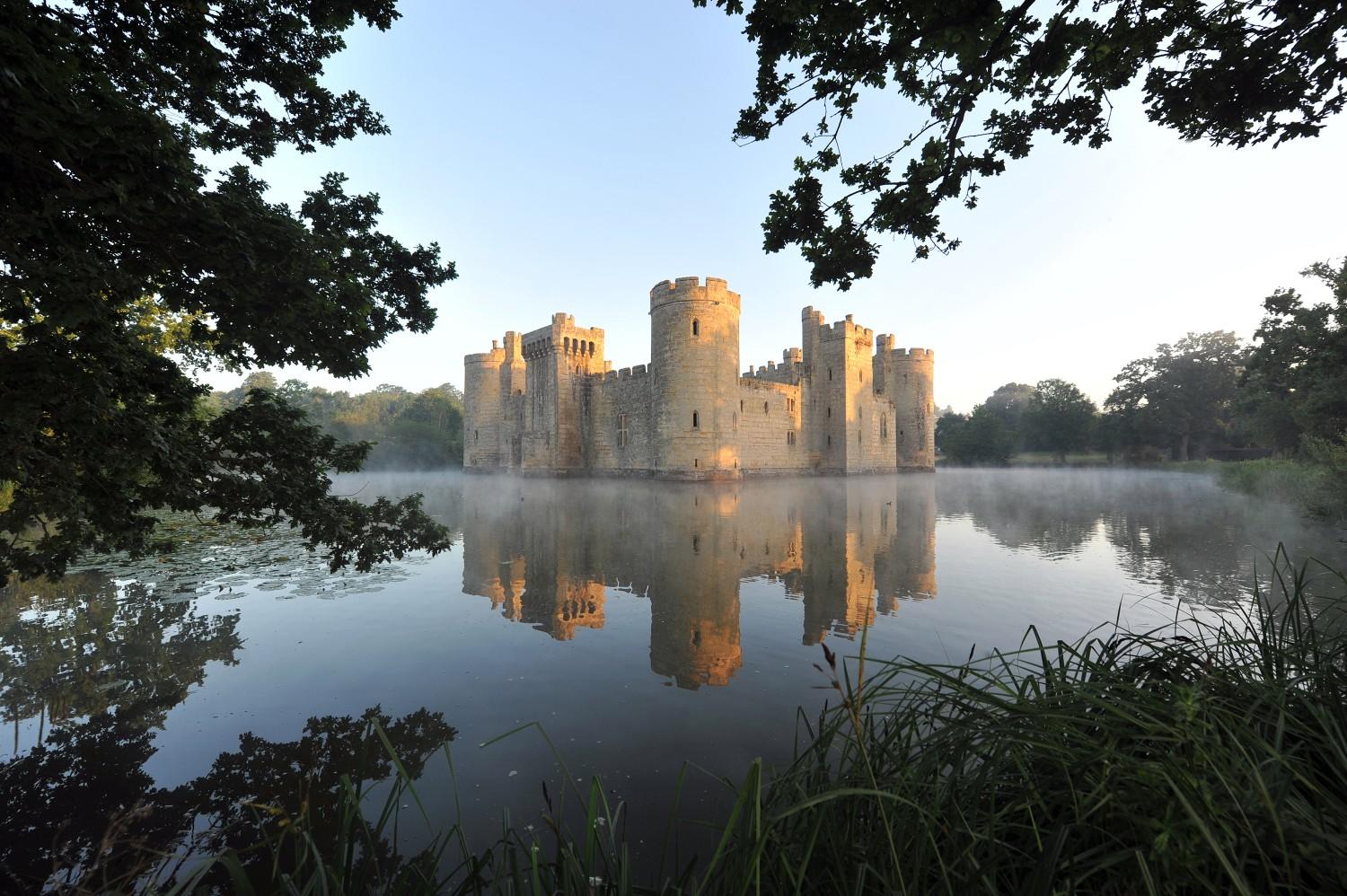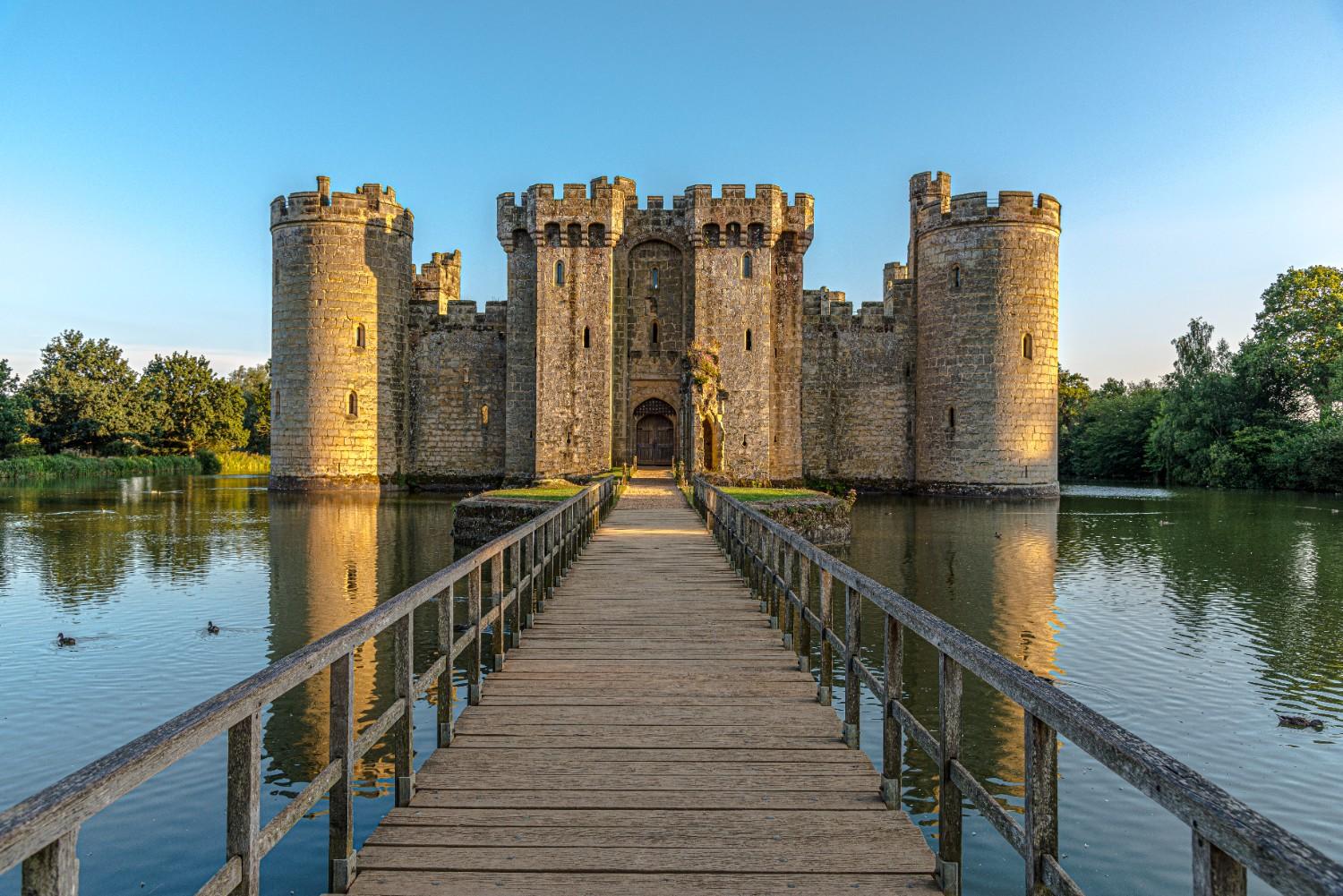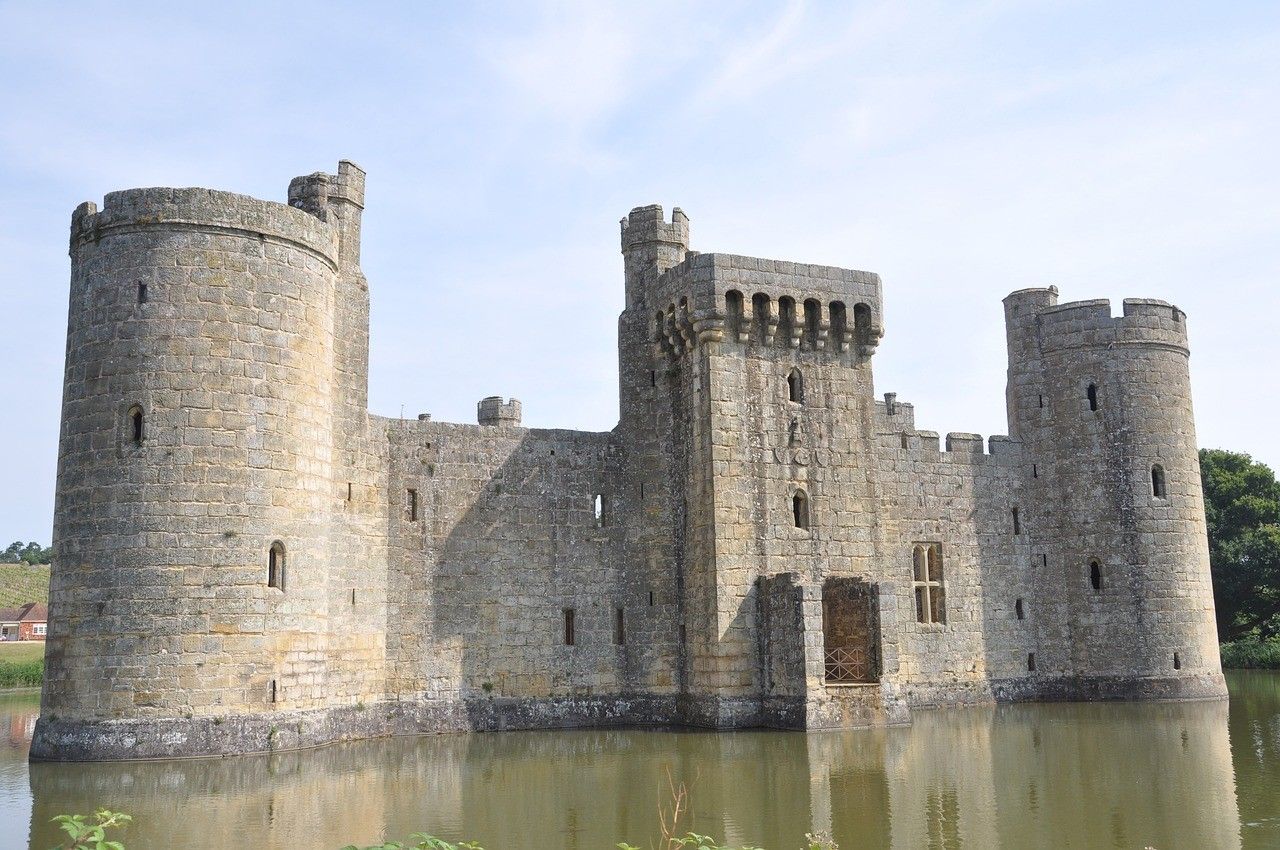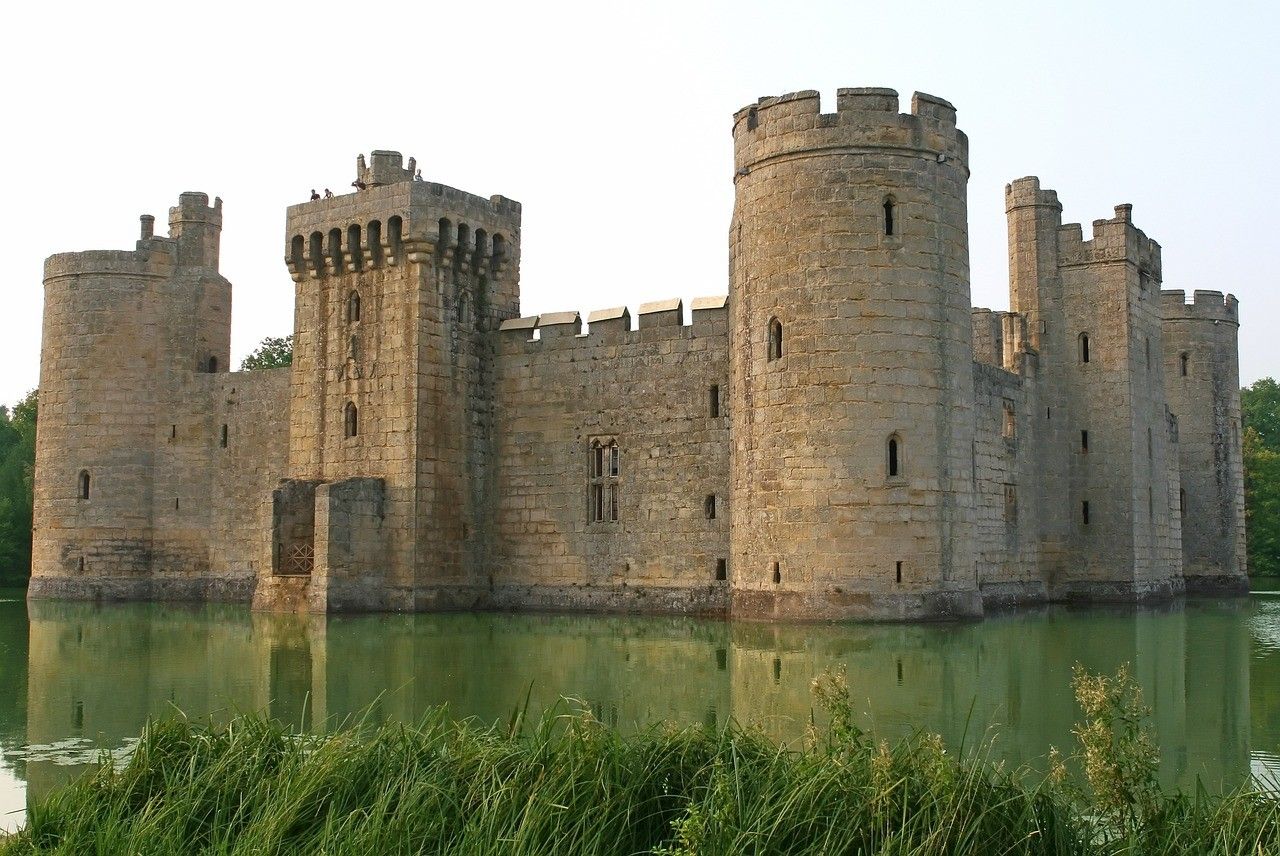Bodiam Castle is a medieval fortress located in the beautiful countryside of East Sussex, England. This magnificent structure, dating back to the 14th century, stands as a testament to the region's rich history and architectural prowess. With its impressive moat, towering walls, and well-preserved interiors, Bodiam Castle has captivated visitors for centuries, offering a glimpse into the life and times of its former inhabitants. As a beloved landmark and a significant piece of England's cultural heritage, Bodiam Castle is the subject of ongoing preservation efforts led by the National Trust, a leading conservation organisation in the UK. Through a combination of restoration projects, educational initiatives, and community engagement, the National Trust is committed to ensuring that this remarkable fortress continues to captivate and inspire visitors for generations to come. So, plan your visit to Bodiam Castle today and embark on a journey through the enchanting world of this remarkable castle
The History of Bodiam Castle
The origins of Bodiam Castle can be traced back to the 14th century, when Sir Edward Dalyngrigge, a former knight of King Edward III, commissioned it.
The Castle's Origins and Construction
The origins of Bodiam Castle can be traced back to the year 1385 when Sir Edward Dalyngrigge, a former knight of King Edward III, commissioned it. Dalyngrigge had fought in the Hundred Years' War and, upon his return, sought to build a stronghold that would serve as both a defensive structure and a comfortable residence. Sir Edward Dalyngrigge's decision to construct the castle was driven by a complex set of political and military factors. As a veteran of the Hundred Years' War, he recognised the strategic importance of controlling the local area, particularly the River Rother, which provided a vital transportation route. By building a fortified castle, Dalyngrigge could assert his power and influence in the region, while also providing a secure refuge for himself and his family. The castle's location was carefully chosen to maximise its defensive capabilities. Nestled along the River Rother, the site offered natural protection from potential invaders, with the river serving as a formidable obstacle. Additionally, the surrounding landscape, with its rolling hills and dense forests, provided additional layers of defence making it difficult for attackers to approach the castle undetected.
The construction of Bodiam Castle was a monumental undertaking, requiring the labour of hundreds of skilled stonemasons, carpenters, and other tradespeople. The castle's rectangular floor plan, with its four sturdy corner towers, was a characteristic feature of late medieval fortifications, providing a well-balanced blend of military and domestic functionality. The castle's outer walls, measuring up to 8 feet thick, were constructed using local sandstone, ensuring that the structure would be able to withstand even the most sustained siege. The gatehouse, with its two flanking towers, served as the primary entrance to the castle and was heavily fortified to deter and repel any unwanted visitors. Overall, the construction of Bodiam Castle was a remarkable feat of engineering and architectural prowess, reflecting the ambition and vision of Sir Edward Dalyngrigge and the skilled craftsmen who brought his plans to life.
The Castle's Turbulent History
Over the centuries, Bodiam Castle has witnessed numerous changes and challenges, each leaving its mark on the structure and its legacy. One of the most significant events in the castle's history occurred during the English Civil War in the 17th century. As tensions between the Royalists and the Parliamentarians escalated, Bodiam Castle found itself caught in the crossfire. In 1643, the castle was besieged by Parliamentarian forces, who eventually succeeded in capturing and occupying the stronghold. The castle's fate was sealed in 1648 when it was ordered to be "slighted" – a process of deliberate destruction to render the structure unusable as a military fortification. This was a common tactic employed during the Civil War, intended to prevent the castle from being used as a strategic asset by either side.
The slighting of Bodiam Castle was a devastating blow, leaving the once-imposing structure in a state of ruin. The castle's towers were deliberately demolished, its walls breached, and its defensive features dismantled. The once-grand interior, which had housed the castle's residents and served as a hub of activity, was left in a state of disrepair. Despite these trials, however, the castle's architectural significance and cultural legacy have endured. Over the centuries, Bodiam Castle has undergone a series of restoration efforts, led by both private and public organizations, to preserve its remaining structures and reclaim its place as a beloved historic site. Today, the castle stands as a testament to the resilience of the human spirit and the enduring power of architectural and cultural heritage. Visitors can still marvel at the castle's impressive ruins, imagining the grandeur and significance it once held, and gain a deeper appreciation for the complex and often turbulent history that has shaped this remarkable fortress.
Architectural Marvels of Bodiam Castle
The architectural design of Bodiam Castle is a true marvel, blending elements of both military and domestic functionality.
The Outer Defenses
The architectural design of Bodiam Castle is a true marvel, blending elements of both military and domestic functionality. The castle's rectangular floor plan, with its four sturdy corner towers, is a classic example of the late medieval style of fortification, reflecting the strategic priorities and defensive needs of the time. The outer walls of Bodiam Castle are a testament to the engineering prowess of its builders. Measuring up to 8 feet thick, these massive stone barriers were constructed using locally sourced sandstone, providing a formidable defence against potential attackers. The sheer scale and solidity of the castle's walls were intended to deter and withstand even the most sustained siege, ensuring the safety and security of its inhabitants. One of the most striking features of the castle's outer defences is the gatehouse, which served as the primary entrance to the fortress. Flanked by two imposing towers, the gatehouse was a heavily fortified structure, designed to repel invaders and control access to the castle's interior. The gatehouse's thick walls, portcullis, and arrow loops (narrow vertical openings in the walls for defending archers) all contributed to its formidable defensive capabilities.
Beyond the gatehouse, the castle's moat, fed by the nearby River Rother, added a layer of protection. This deep, water-filled trench surrounding the castle's walls was a classic feature of medieval fortifications, serving as a deterrent to potential attackers and making it more difficult for them to approach and assault the castle. The combination of the castle's thick stone walls, towering corner towers, and formidable moat created an imposing and well-defended structure, one that would have been a daunting challenge for any would-be invaders to overcome. These architectural elements not only served a practical purpose in terms of defence but also contributed to the castle's overall aesthetic, lending it an air of power and grandeur that has captivated visitors for centuries.
The Castle's Interior
While the exterior of Bodiam Castle was designed with military might in mind, the interior of the structure was also crafted with a keen eye for comfort and functionality. The castle's well-preserved ruins provide a glimpse into the daily lives and routines of its former inhabitants, offering a unique insight into the social and domestic aspects of medieval castle life. One of the most impressive features of the castle's interior is the great hall, a spacious and ornate chamber that served as the centrepiece of the structure. This grand room was the setting for a variety of social and ceremonial activities, from formal banquets and receptions to daily communal meals and gatherings. The great hall's soaring ceilings, ornate fireplace, and intricate architectural details speak to the wealth and status of the castle's owners, as well as the importance of hospitality and entertainment in the social fabric of medieval society.
Adjoining the great hall were a range of other living quarters and support spaces, including the kitchen, the chapel, and the private chambers of the castle's residents. These areas, while more utilitarian, were nonetheless designed with an eye for comfort and functionality, reflecting the dual role of Bodiam Castle as both a fortified stronghold and a comfortable residence. The castle's well-preserved moat, fed by the nearby River Rother, was a crucial defensive feature and played a vital role in the daily life of the castle's inhabitants. The moat provided a means of transportation and communication, allowing the castle's residents to move supplies and resources, as well as maintain connections with the surrounding community. Overall, the interior of Bodiam Castle offers a glimpse into the rich and multifaceted nature of medieval castle life, blending elements of military might, domestic comfort, and social significance. The castle's well-preserved ruins continue to captivate and inspire visitors, inviting them to immerse themselves in the history and daily routines of its former occupants.
Exploring the Grounds of Bodiam Castle
Surrounding the castle itself is a vast and picturesque estate, offering visitors a chance to immerse themselves in the natural beauty of the region.
The Scenic Riverside Walk
Surrounding the castle itself is a vast and picturesque estate, offering visitors a chance to immerse themselves in the natural beauty of the region. The castle's grounds are home to a variety of native plant and animal species, making it a haven for nature enthusiasts and outdoor enthusiasts alike. One of the most popular activities on the grounds is the scenic riverside walk. Visitors can stroll along the banks of the River Rother, taking in the serene beauty of the landscape and catching glimpses of the castle's impressive silhouette in the distance. The riverside walk also provides an opportunity to observe the diverse array of flora and fauna that call the castle's grounds home. Keep an eye out for a variety of bird species, including herons, kingfishers, and swans, as they gracefully navigate the waterway. The surrounding woodlands and meadows are also teeming with life, from delicate wildflowers to scurrying woodland creatures. The castle's grounds offer a network of well-maintained trails that wind through the estate, offering opportunities for hiking, birdwatching, and simply taking in the peaceful ambience of the natural surroundings.
The Castle Towers and Panoramic Views
For those interested in the castle's defensive features and architectural details, the castle's towers offer a unique vantage point from which to survey the surrounding area. Visitors can climb to the top of the towers and enjoy panoramic views of the estate, as well as the nearby village of Bodiam. Ascending the castle's towers is a thrilling and enlightening experience, providing a glimpse into the strategic considerations that guided the construction of this medieval fortress. From the tower's elevated perspectives, visitors can better understand the castle's defensive capabilities and the challenges that any potential attackers would have faced. The towers' arrow loops and battlements serve as a tangible reminder of the castle's military function, underscoring the strategic importance of its location and the technical expertise of its builders. For those interested in architecture and engineering, the castle's towers also offer a chance to appreciate the intricate construction techniques employed in their creation. The towers' sturdy, tapered walls and carefully designed structural elements reflect the advanced building methods of the medieval period, adding to the overall sense of awe and admiration that visitors experience during their visit.
The Village of Bodiam and Surrounding Attractions
Located just a short distance from Bodiam Castle is the charming village of Bodiam, as well as the nearby town of Robertsbridge and the Rye Harbour Nature Reserve
The Historic Village of Bodiam
Located just a short distance from Bodiam Castle is the charming village of Bodiam, which has a rich history of its own. The village's roots can be traced back centuries, with many of its historic buildings and structures still standing today, offering visitors a glimpse into the region's past. One of the most notable landmarks in the village is the 13th-century St Giles' Church. This beautifully preserved ecclesiastical structure is a true architectural gem, boasting a unique bell tower and intricate details that showcase the skill and craftsmanship of its medieval builders. The picturesque High Street is lined with charming cottages, many of which date back to the 17th and 18th centuries, providing a glimpse into the village's prosperous past as a centre of agricultural and commercial activity. You'll also come across many traditional country pubs and inns, some of which have been serving the local community for generations. These establishments not only offer a welcoming respite for weary travellers but also provide a glimpse into the social and cultural traditions that have shaped the village over time. For those interested in learning more about the history and heritage of Bodiam, the village's local museum is a must-visit destination. Here, you'll find a wealth of information and artefacts that tell the story of the community's evolution, from its medieval roots to its present-day incarnation as a charming rural oasis. Overall, the village of Bodiam is a captivating and well-preserved example of the region's rich cultural legacy.
Exploring the Town of Robertsbridge
Just a few miles from Bodiam Castle is the town of Robertsbridge, a picturesque market town that serves as a hub for the local community. This vibrant and well-preserved settlement offers visitors a chance to experience the authentic charm and character of the East Sussex countryside, with a diverse array of independent shops, cosy cafes, and traditional pubs lining its bustling High Street. One of the standout features of Robertsbridge is its rich historical legacy. The town's origins can be traced back to the 13th century when it was established as a new town by the monks of Battle Abbey. Over the centuries, Robertsbridge has witnessed a succession of cultural and economic transformations, each contributing to its unique identity and enduring appeal.
Beyond its historic buildings, Robertsbridge is also home to a thriving local community, with a diverse array of independent businesses and artisanal producers that cater to the needs and interests of both residents and visitors alike. Robertsbridge also serves as a gateway to a range of outdoor recreational opportunities. The town's proximity to the picturesque River Rother and the surrounding countryside makes it an ideal base for hiking, cycling, and other outdoor pursuits, allowing visitors to fully experience the beauty and tranquillity of the East Sussex landscape. Overall, the town of Robertsbridge is a must-visit destination for anyone exploring the region around Bodiam Castle. With its rich history, thriving local culture, and stunning natural surroundings, it offers a multifaceted and eminently rewarding experience that will leave a lasting impression on all who venture there.
The Rye Harbour Nature Reserve
Another nearby attraction that is well worth a visit is the Rye Harbour Nature Reserve, a stunning coastal nature reserve that is home to a diverse array of plant and animal life. Situated just a short distance from Bodiam Castle, the reserve offers visitors a chance to immerse themselves in the region's unique natural heritage and appreciate the breathtaking beauty of the East Sussex coastline. Covering an area of over 1,100 acres, the Rye Harbour Nature Reserve is a true haven for nature enthusiasts and outdoor adventurers. The reserve's diverse habitats, ranging from shingle beaches and salt marshes to freshwater pools and grasslands, support a wide variety of flora and fauna, including many rare and endangered species.
One of the reserve's most impressive features is its extensive network of well-maintained trails and footpaths, which allow visitors to explore the various ecosystems and habitats that make up this captivating natural landscape. The Rye Harbour Nature Reserve is particularly renowned for its birdwatching opportunities, with over 280 species of birds having been recorded within its boundaries. From the graceful wading birds that stalk the shoreline to the vibrant songbirds that flit through the reserve's wooded areas, there is a wealth of avian life for visitors to discover and observe. In addition to its rich avian diversity, the reserve is also home to a variety of other fascinating wildlife, including a range of invertebrates, small mammals, and reptiles. Keen-eyed visitors may spot the distinctive tracks of the reserve's resident deer population or catch a glimpse of the elusive water voles that thrive in the reserve's wetland habitats.
Bodiam Castle as a Wedding Venue
In recent years, Bodiam Castle has become a popular destination for couples looking to tie the knot in a truly unique and historic setting
The Castle's Event Spaces
In recent years, Bodiam Castle has become a popular destination for couples looking to tie the knot in a truly unique and historic setting. The castle's stunning architecture and picturesque surroundings provide the perfect backdrop for a memorable wedding celebration, offering a level of grandeur and elegance that is unparalleled in the region. The castle's event spaces are well-suited to accommodate a range of wedding party sizes, from intimate gatherings to larger, more elaborate celebrations. The great hall, with its soaring ceilings and ornate fireplace, is a particularly magnificent setting for the ceremony itself, allowing couples to exchange vows against the backdrop of the castle's impressive medieval architecture. For the reception, the outer bailey of the castle offers ample space for guests to mingle, dine, and dance the night away. This expansive area, which was once used for military drills and exercises, has been carefully curated to provide a stunning and versatile event space, with the castle's towering walls and turrets serving as a majestic natural backdrop.
Couples who choose to host their wedding at Bodiam Castle have the opportunity to work closely with the castle's experienced event staff to customise every aspect of their celebration. From the selection of catering and bar services to the design of the floral arrangements and table settings, the castle's team is committed to ensuring that each wedding is a truly bespoke and unforgettable experience. One of the key advantages of hosting a wedding at Bodiam Castle is the exclusivity and privacy that the venue can offer. By arranging for exclusive use of the castle and its grounds, couples can create a truly immersive and intimate atmosphere, allowing their guests to fully embrace the historic charm and grandeur of the setting.
Additional Wedding Services
For those looking to make their wedding day at Bodiam Castle even more special, the venue offers a range of additional services and amenities that can enhance the overall experience. One of the most popular options is the opportunity to have the ceremony performed within the castle's 14th-century chapel. This sacred space, with its intricate architectural details and serene atmosphere, provides a truly breathtaking setting for the exchange of vows, imbuing the occasion with a sense of timelessness and reverence. Couples who choose to utilise the chapel can work closely with the castle's event staff to ensure that the ceremony is tailored to their specific needs and preferences, from the selection of readings and music to the incorporation of personal elements and traditions.
In addition to the chapel, Bodiam Castle also offers couples the opportunity to have their photographs taken in a variety of stunning locations throughout the grounds. From the castle's imposing towers and battlements to the serene banks of the River Rother, the venue's picturesque settings provide a wealth of opportunities for capturing the perfect wedding day memories. For those who want to extend their wedding celebrations, Bodiam Castle can also accommodate overnight stays, with a range of luxury accommodations available both within the castle and in the surrounding estate. This allows couples and their guests to fully immerse themselves in the castle's historic ambience and enjoy a truly exclusive and unforgettable wedding experience. Overall, the combination of Bodiam Castle's breathtaking setting, flexible event spaces, and an array of additional services make it a truly unique and sought-after wedding venue. By choosing to celebrate their nuptials at this iconic medieval fortress, couples can create a wedding day that is not only visually stunning but also imbued with a sense of history, romance, and enduring tradition.
Preserving the Legacy of Bodiam Castle
As a beloved landmark and a significant piece of England's cultural heritage, Bodiam Castle is the subject of ongoing preservation efforts led by the National Trust.
The National Trust's Efforts
As a beloved landmark and a significant piece of England's cultural heritage, Bodiam Castle is the subject of ongoing preservation efforts led by the National Trust, a leading conservation organisation in the UK. The National Trust's unwavering commitment to maintaining the castle's structural integrity and protecting its historical significance has been instrumental in ensuring that this remarkable fortress continues to captivate and inspire visitors for generations to come. The National Trust's stewardship of Bodiam Castle is a multifaceted endeavour, encompassing a range of restoration, conservation, and educational initiatives. From stabilising the castle's walls and towers to carefully preserving the remaining architectural features, the organisation's team of experts works tirelessly to safeguard the integrity of the structure and prevent further deterioration.
One of the National Trust's key priorities is to ensure that the castle's rich history and cultural significance are not only preserved but also shared with the public. To this end, the organisation has implemented a comprehensive program of interpretive activities and educational resources, designed to help visitors gain a deeper understanding and appreciation of the castle's past. Through guided tours, interactive exhibits, and informative signage, the National Trust encourages visitors to immerse themselves in the castle's captivating stories, exploring the lives and experiences of its former inhabitants and the broader historical context that shaped its development. By bringing the castle's history to life in this way, the National Trust not only enhances the visitor experience but also fosters a deeper sense of connection to this remarkable site.
Beyond its efforts to preserve the castle's physical fabric and share its stories, the National Trust is also committed to ensuring that Bodiam Castle remains a vibrant and accessible destination for all. The organisation works closely with local communities, organising a range of events and activities throughout the year that celebrate the castle's heritage and engage the public in its ongoing stewardship. From hosting lively festivals and reenactments to leading conservation-focused volunteer programs, the National Trust's initiatives at Bodiam Castle are designed to foster a sense of collective ownership and investment in the castle's future. By empowering and inspiring residents and visitors alike, the organisation aims to ensure that this remarkable fortress continues to hold a central place in the hearts and minds of all who encounter it.
Initiatives and Community Involvement
The National Trust's unwavering commitment to preserving the legacy of Bodiam Castle extends far beyond the castle's physical structure, encompassing a range of innovative initiatives and community engagement efforts that help to ensure the enduring significance of this historic site. One of the National Trust's key priorities is to foster a deeper understanding and appreciation of the castle's cultural heritage, not just among visitors, but within the local community as well. To this end, the organisation has developed a robust educational program, offering a variety of interactive workshops, guided tours, and hands-on learning experiences that cater to learners of all ages. Through these initiatives, the National Trust aims to inspire a sense of wonder and curiosity about the castle's past, encouraging participants to explore the complex web of historical, architectural, and social narratives that have shaped this remarkable fortress. Whether it's a guided tour of the castle's medieval architecture or a hands-on workshop on traditional building techniques, these educational programs are designed to engage and enlighten, fostering a deeper connection to the site's cultural legacy. From seasonal festivals and reenactments to conservation-focused volunteer programs, these collaborative initiatives not only draw visitors to the site but also empower residents to become active stewards of their shared cultural heritage.
One particularly noteworthy example of the National Trust's community engagement efforts is the annual Bodiam Castle Festival, a vibrant celebration that brings together thousands of visitors from near and far to experience the castle's history and culture in an immersive, interactive manner. This event features a diverse array of live performances, hands-on workshops, and historical reenactments, all designed to transport attendees back in time and foster a deeper appreciation for the castle's enduring legacy. Through these and other community-focused initiatives, the National Trust has established Bodiam Castle as a hub of cultural activity and civic engagement, where locals and visitors alike can come together to learn, explore, and collectively steward the preservation of this remarkable historical site. By empowering and inspiring people to engage with the castle's past, the National Trust ensures that its legacy will continue to endure and evolve for generations to come.
Visiting Bodiam Castle: Tips and Practical Information
Planning Your Visit — When planning a visit to Bodiam Castle, it's important to note that the castle is located in a rural area, so parking can be limited. Visitors are encouraged to plan their trip and consider alternative modes of transportation, such as public buses or even bicycles.
Navigating the Castle and Grounds — For those who wish to make the most of their visit, the castle's website offers a wealth of information, including opening hours, admission fees, and details on various events and activities taking place throughout the year. Visitors can also take advantage of the castle's audio tour, which provides a deeper understanding of the castle's history and architecture.
Nearby Amenities and Attractions — In addition to the castle itself, there are several nearby attractions and amenities that visitors may wish to explore. The village of Bodiam offers a range of dining and shopping options, while the town of Robertsbridge provides a more comprehensive array of services and entertainment.
Related Articles

Let us know you agree to cookies
We use marketing, analytical and functional cookies as well as similar technologies to give you the best experience. Third parties, including social media platforms, often place tracking cookies on our site to show you personalised adverts outside of our website.
We store your cookie preferences for two years and you can edit your preferences via ‘manage cookies’ or through the cookie policy at the bottom of every page. For more information, please see our cookie policy.

